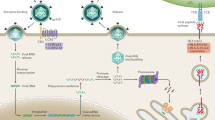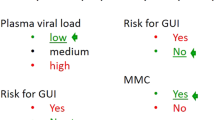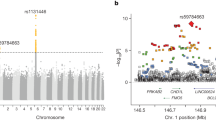Abstract
Discernable genetic variation among people and populations has an important role in infectious disease epidemics, including that of acquired immune deficiency syndrome (AIDS). Genetic association analysis of several large AIDS cohorts implicate 14 AIDS restriction genes, polymorphic variants in loci that regulate HIV-1 cell entry, acquired and innate immunity, and cytokine defenses to HIV-1. The influence and translational impact of these genes on individual and population sensitivity to AIDS is considerable.
This is a preview of subscription content, access via your institution
Access options
Subscribe to this journal
Receive 12 print issues and online access
$259.00 per year
only $21.58 per issue
Buy this article
- Purchase on SpringerLink
- Instant access to full article PDF
Prices may be subject to local taxes which are calculated during checkout



Similar content being viewed by others
References
Palella, F.J. Jr. et al. Declining morbidity and mortality among patients with advanced human immunodeficiency virus infection. HIV outpatient Study Investigators. N. Engl. J. Med. 338, 853–860 (1998).
Mocroft, A. et al. Changing patterns of mortality across Europe in patients infected with HIV-1. EuroSIDA Study Group. Lancet 352, 1725–1730 (1998).
Finzi, D. et al. Latent infection of CD4+ T cells provides a mechanism for lifelong persistence of HIV-1, even in patients on effective combination therapy. Nat. Med. 5, 512–517 (1999).
Cohen, J. Shots in the Dark. The wayward search for an AIDS vaccine. (W. Norton, New York, 2001).
Fauci, A.S. HIV and AIDS: 20 years of science. Nat. Med. 9, 839–843 (2003).
Weiss, R.A. HIV and AIDS: looking ahead. Nat. Med. 9, 887–891 (2003).
Annan, K. Forward. in AIDS in Africa (eds. Essex, M., Mboup, S., Kanki, P.J., Marlink, R. & Tlou, S.D.) 2nd edn. (Kluwer Academic, New York, 2002).
O'Brien, S.J. & Moore, J. The effect of genetic variation in chemokines and their receptors on HIV transmission and progression to AIDS. Immunol. Rev. 177, 99–111 (2000).
Carrington, M. & O'Brien, S.J. The influence of HLA genotype on AIDS. Ann. Rev. Med. 54, 535–551 (2003).
O'Brien, S.J. & Dean, M. In search of AIDS-resistance genes. Sci. Am. 277, 44–51 (1997).
O'Brien, S.J. AIDS: A role for host genes. Hosp. Pract. 33, 53–79 (1998).
Cox, D.R. & Oakes, D. Analysis of Survival Data, London (Chapman and Hall, 1984).
Allison, P.D. Survival analyses using the SAS system: A practical guide. 155–197 (SAS Institute, Cary, North Carolina, 1995).
O'Brien, S.J., Nelson, G.W., Winkler, C.A. & Smith, M.W. Polygenic and multifactorial disease gene association in man: Lessons from AIDS. Annu. Rev. Genet. 34, 563–591 (2000).
Gulick, R.M. New antiretroviral drugs. Clin. Microbiol. Infect. 9, 186–193 (2003).
Carrington, M., Nelson, G. & O'Brien, S.J. Considering genetic profiles in functional studies of immune responsiveness to HIV-1. Immunol. Lett. 79, 131–140 (2001).
Dean, M. et al. Genetic restriction of HIV-1 infection and progression to AIDS by a deletion allele of the CKR5 structural gene. Science 273, 1856–1862 (1996).
Liu, R. et al. Homozygous defect in HIV-1 coreceptor accounts for resistance of some multiply-exposed individuals to HIV-1 infection. Cell 86, 367–377 (1996).
Samson, M. et al. Molecular cloning and functional expression of a new human CC chemokine receptor gene. Biochemistry 35, 3362–3367 (1996).
Winkler, C.A. & O'Brien, S.J. AIDS restriction genes in human ethnic groups: An assessment. in AIDS in Africa (eds. Essex, M., Mboup, S., Kanki, P.J., Marlink, R. & Tlou, S.D.) 2nd edn. (Kluwer Academic, New York, 2002).
Winkler, C., Ping, A. & O'Brien, S.J. Patterns of ethnic diversity among the genes that influence AIDS. Hum. Mol. Genet. 13, R9–R19 (2004).
D'Souza, M.P. & Harden, V.A. Chemokines and HIV-1 second receptors - confluence of two fields generates optimism in AIDS research. Nat. Med. 2, 1293–1300 (1996).
Berger, E.A., Murphy, P.M. & Farber, J.M. Chemokine receptors as HIV-1 coreceptors: Roles in Viral Entry, Tropism, and Disease. Annu. Rev. Immunol. 17, 657–700 (1999).
McNicholl, J.M., Smith, D.K., Qari, S.H. & Hodge, T. Host genes and HIV: The role of the chemokine receptor gene CCR5 and its allele (?32 CCR5) Emerging. Infect. Dis. 3, 261–271 (1997).
Schemper, M. Predictive accuracy and explained variation. Stat. Med. 22, 2299–2308 (2003).
Risch, N. & Merikangas, K. The future of genetic studies of complex human diseases. Science 273, 1517–1517 (1996).
Pritchard, J.K., Stephens, M., Rosenberg, N.A. & Donnelly, P. Association mapping in structured populations. Am. J. Hum. Genet. 67, 170–181 (2000).
Glazier, A.M., Nadeau, J.H. & Aitman, T.J. Finding genes that underlie complex traits. Science 298, 2345–2349 (2003).
Anonymous. Freely associating. Nat. Genet. 22, 1–2 (1999).
Pritchard, J.K. & Donnelly, P. Case-control studies of association in structured or admixed populations. Theor. Popul. Biol. 60, 227–237 (2001).
Falush, D., Stephens, D. & Pritchard, J.K. Inferences of population structure using multilocus genotype data: linked loci and correlated allele frequencies. Genetics 164, 1567–1587 (2003).
Wu, L. et al. CCR5 levels and expression, pattern correlate with infectability by macrophage-tropic HIV-1, in vitro. J. Exp. Med. 185, 1681–1691 (1997).
Benkirane, M., Jin, D.Y., Chun, R.F., Koup, R.A. & Jeang, K-T. Mechanism of transdominant inhibition of CCR5-mediated HIV-1 infection by CCR5 Delta 32. J. Biol. Chem. 272, 30603–30606 (1997).
Martin, M.P. et al. Genetic acceleration of AIDS progression by a promoter variant of CCR5. Science 282, 1907–1911 (1998).
Carrington, M., Dean, M., Martin, M.P. & O'Brien, S.J. Genetics of HIV-1 infection: Chemokine receptor CCR5 polymorphism and its consequences. Hum. Mol. Genet. 8, 1939–1945 (1999).
Salkowitz, J.R. et al. CCR5 promoter polymorphism determines macrophage CCR5 density and magnitude of HIV-1 propagation in vitro. Clin. Immunol. 108, 234–240 (2003).
Bream, J.H. et al. CCR5 promoter alleles distinguished by specific DNA binding factors. Science 284, 223a (1999).
Smith, M.W. et al. Contrasting genetic influence of CCR2 and CCR5 receptor gene variants on HIV-1 infection and disease progression. Science 277, 959–965 (1997).
Anzala, A.O. et al. CCR2-64I allele and genotype association with delayed AIDS progression in African women. Lancet 351, 1632–1633 (1998).
Lee, B. et al. Influence of the CCR2-V64I polymorphism on human immunodeficiency virus type 1 coreceptor activity and on chemokine receptor function of CCR2b, CCR3, CCR5, and CXCR4. J. Virol. 72, 7450–7458 (1998).
Mariani, R. et al. CCR2-64I polymorphism is not associated with altered CCR5 expression or coreceptor function. J. Virol. 73, 2450–2459 (1999).
Mellado, M., Rodriguez-Frade, J.M., Vila-Coro, A.J., de Ana, A.M. & Martinez, A.C. Chemokine control of HIV-1 infection. Nature 400, 723–724 (1999).
Zagury, D. et al. C-C chemokines, pivotal in protection against HIV type 1 infection. Proc. Natl. Acad. Sci. USA 95, 3857–3861 (1998).
Gallo, R.C., Garzino-Demo, A. & DeVico, A.L. HIV infection and pathogenesis: what about chemokines? J. Clin. Immunol. 19, 293–299 (1999).
An, P. et al. Modulation of HIV infection and disease progression by interacting RANTES variants. Proc. Natl. Acad. Sci USA 99, 10002–10007 (2002).
Winkler, C. et al. Genetic restriction of AIDS pathogenesis by an SDF-1 chemokine gene variant. Science 279, 389–393 (1998).
Bleul, C.C. et al. The lymphocyte chemoattractant SDF-1 is a ligand for LESTR/fusin and blocks HIV-1 entry. Nature 382, 829–833 (1996).
Duggal, P. et al. Genetic influence of CXCR6 chemokine receptor alleles on PCP-mediated AIDS progression among African-Americans. Genes Immun. 4, 245–250 (2003).
Modi, W.S. et al. Directional selection in the MCP-1 MCP-3 Eotaxin gene cluster in influences HIV-1 transmission. AIDS 17, 2357–2365 (2003).
Bagiolini, M. et al. IL-8 and related chemotactic cytokines-CXC and CC chemokines. Adv. Immunol. 55, 97–179 (1994).
He, J.L. et al. CCR3 and CCR5 are co-receptors for HIV-1 infection of microglia. Nature 385, 645–649 (1997).
Sozzani, S. et al. Differential regulation of chemokine receptors during dendritic cell maturation: a model for their trafficking properties. J. Immunol. 161, 1083–1086 (1998).
Shin, H.D. et al. Genetic restriction of HIV-1 infection and AIDS progression by promoter alleles of interleukin 10. Proc. Natl. Acad. Sci. USA. 97, 14467–14472 (2000).
Bream, J.H., An, P., Zhang, X., Winkler, C.A. & Young, H.A. A single nucleotide polymorphism in the proximal IFN-gamma promoter alters control of gene transcription. Genes Immun. 3, 165–169 (2002).
An, P. et al. A TNF-inducible promoter variant of interferon-gamma accelerates CD4 T cell depletion in HIV-1 infected individuals. J. Infect. Dis. 188, 228–231 (2003).
Aguado, B. et al. Complete sequence and gene map of a human major histocompatibility complex. The MHC sequencing consortium. Nature 401, 921–923 (1999).
Parham, P. & Ohta, T. Population biology of antigen presentation by MHC class I molecules. Science 272, 67–74 (1996).
Hughes, A.L. & Yeager, M. Natural selection at major histocompatibility complex loci of vertebrates. Annu. Rev. Genet. 32, 415–435 (1998).
Barber, L.D. et al. Overlap in the repertoires of peptides bound in-vivo by a group of related Class-I HLA-B allotypes. Curr. Biol. 5, 179–190 (1995).
Gao, X. et al. Effect of a single amino acid change in MHC class I molecules on the rate of progression to AIDS. N. Engl. J. Med. 344, 1668–1675 (2001).
Moore, C.B. et al. Evidence of HIV-1 adaptation to HLA-restricted immune response at a population level. Science 296, 1439–1443 (2003).
Carrington, M. et al. HLA and HIV-1: Heterozygote advantage and B*35-Cw*04 disadvantage. Science 283, 1748–1752 (1999).
Steinle, A. et al. Motif of HLA-B*3503 peptide ligands. Immunogenetics 43, 105–107 (1996).
Jin, X. et al. Human immunodeficiency virus Type 1 (HIV-1)-specific CD8+-T-Cell responses for groups of HIV-1-infected individuals with different HLA-B*35 genotypes. J. Virol. 76, 12603–12610 (2002).
O'Brien, S.J., Gao, X. & Carrington, M. HLA and AIDS: A cautionary tale. Trends Mol. Med. 7, 379–381 (2002).
Tang, J.M. et al. HLA class I homozygosity accelerates disease progression in human immunodeficiency virus type I infection. AIDS Res. Hum. Retroviruses 15, 317–324 (1999).
Flores-Villanueva, P.O. et al. Control of HIV-1 viremia and protection from AIDS are associated with HLA-Bw4 homozygosity. Proc. Natl. Acad. Sci. USA 98, 5140–5145 (2001).
Trachtenberg, E. et al. Advantage of rare HLA supertype in HIV disease progression. Nat. Med. 9, 928–935 (2003).
Lanier, L.L. NK cell receptors. Annu. Rev. Immunol. 16, 359–393 (1998).
Martin, M.P. et al. Epistatic interaction between KIR3DS1 and HLA-B delays the progression to AIDS. Nat. Genet. 31, 429–434 (2002).
Cairns, J.S. & D'Souza, M.P. Chemokines and HIV-1 second receptors: The therapeutic connection. Nat. Med. 4, 563–568 (1998).
O'Brien, S.J. A new approach to therapy. HIV Newsline 4, 3–6 (1998).
LaBranche, C.C. et al. HIV fusion and its inhibition. Antiviral Res. 50, 95–115 (2001).
Stevenson, M. New targets for inhibitors of HIV-1 replication. Nat. Rev. Mol. Cell Biol. 1, 40–49 (2000).
Hazuda, D.J. et al. Inhibitors of strand transfer that prevent integration and inhibit HIV-1 replication in cells. Science 287, 646–650 (2000).
Best, S., Le Tissier, P., Towers, G. & Stoye, J.P. Positional cloning of the mouse retrovirus restriction gene Fv-1. Nature 382, 826–829 (1996).
Levin, M.L. The occurrence of lung cancer in man. Acta Unio Int. Contra Cancrum 9, 531–541 (1953).
Benichou, J. Attributable Risk. in Encyclopedia of Statistics. (eds. Armitage, P. & Colton, T.) (Wiley, New York, 1998).
Goedert, J.J. et al. A prospective study of human immunodeficiency virus type 1 infection and the development of AIDS in subjects with hemophilia. N. Engl. J. Med. 321, 1141–1148 (1989).
Darby, S.C., Doll, R., Thakrar, B., Rizza, C.R. & Cox, D.R. Time from infection with HIV to onset of AIDS in patients with haemophilia in the UK. Stat. Med. 6, 681–689 (1990).
The International Hap Map Project. Nature 426, 789–796 (2003).
Phair, J. et al. Acquired-Immune-Deficiency-Syndrome occurring within 5 years of infection with Human-Immunodeficiency-Virus Type-1 - the Multicenter AIDS Cohort Study. J. Acquir. Immune Defic. Syndr. 5, 490–496 (1992).
Detels, R. et al. For the Multicenter AIDS Cohort Study: Resistance to HIV-1 infection. J. Acquir. Immune Defic. Syndr. 7, 1263–1269 (1994).
Kaslow, R.A. et al. The Multicenter AIDS Cohort Study - Rationale, organization, and selected characteristics of the participants. Am. J. Epidemiol. 26, 310–318 (1987).
Buchbinder, S.P., Katz, M.H., Hessol, N.A., O'Malley, P.M. & Holmberg, S.D. Long-term HIV-1 infection without immunologic progression. AIDS 8, 1123–1128 (1994).
Goedert, J.J. et al. Decreased helper lymphocytes-T in homosexual men. 1. Sexual contact in high-incidence areas for the Acquired Immunodeficiency Syndrome. Am. J. Epidemiol. 121, 629–636 (1985).
Hilgartner, M.W. et al. Hemophilia growth and development study - design, methods, and entry data. Am. J. Ped. Hematol. Oncol. 15, 208–218 (1993).
Lederman, M.M. et al. Human immunodeficiency virus (HIV) type 1 infection status and in vitro susceptibility to HIV infection among high-risk HIV-1-seronegative hemophiliacs. J. Infect. Dis. 172, 228–231 (1995).
Vlahov, D. et al. Association of drug injection patterns with antibody to human immunodeficiency virus type 1 among intravenous durg users in Baltimore, Maryland. Am. J. Epidemiol. 132, 847–856 (1990).
Dean, M. et al. Reduced risk of AIDS lymphoma in individuals heterozygous for the CCR5-?32 mutation. Cancer Res. 59, 3561–3564 (1999).
US Centers for Disease Control. Morb. Mortal. Wkly. Rep. 36 Suppl 1 (1987).
Goldsmith, M.A. & Doms, R.W. HIV entry: are all receptors created equal? Nat. Immunol. 3, 709–710 (2002).
Littman, D.R. Chemokine receptors: keys to AIDS pathogenesis? Cell 93, 677–680 (1998).
Kullback, S. Information Theory and Statistics (Dover, Mineola, New York, 1968).
Nilsson, S., Carstensen, J.M. & Pershagen, G. Mortality among male and female smokers in Sweden: a 33 year follow up. J. Epidemiol. Community Health 55, 825–830 (2001).
Author information
Authors and Affiliations
Corresponding author
Rights and permissions
About this article
Cite this article
O'Brien, S., Nelson, G. Human genes that limit AIDS. Nat Genet 36, 565–574 (2004). https://doi.org/10.1038/ng1369
Received:
Accepted:
Published:
Issue date:
DOI: https://doi.org/10.1038/ng1369
This article is cited by
-
Cysteine-cysteine chemokine receptor 5 (CCR5) profile of HIV-infected subjects attending University of Calabar Teaching Hospital, Calabar, Southern Nigeria
BMC Infectious Diseases (2020)
-
The role of cullin 5-containing ubiquitin ligases
Cell Division (2016)
-
Cerebrospinal Fluid Biomarkers of Simian Immunodeficiency Virus Encephalitis
Journal of Neuroimmune Pharmacology (2016)
-
GWATCH: a web platform for automated gene association discovery analysis
GigaScience (2014)
-
Association of the HLA-B*52 allele with non-progression to AIDS in Brazilian HIV-1-infected individuals
Genes & Immunity (2014)



